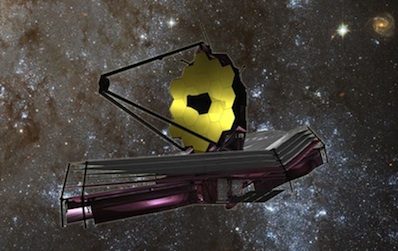Authors: C. H. Blake & M. M. Shaw
Ground based astronomical observing has one major obstacle that it must over come in order to produce quality, science quality data: Earth's atmosphere. Methods to correct for atmospheric attenuation are familiar to anyone who has taken data at a ground based telescope, or who have at least studied observational astronomy. As an example, observations of "standard" stars are required in order to calibrate not only the detector, but also to differentially correct for atmospheric effects on a given night.
 |
| Figure 1: Components of atmospheric absorption presented in Blake & Shaw (2011) |
Atmospheric absorption and attenuation is particularly noticeable in the near infrared (NIR) where absorption bands due to the molecular species in the atmosphere efficiently absorb much of the incoming flux. Typically, narrow band filters that have transmission peaks between these molecular bands are utilized in order to skirt around the difficult procedure of correcting for molecular absorption.
However, in this paper, Blake and Shaw propose a very unique and interesting method for correcting astronomical images that have been affected by the absorption due to water molecules. They propose using signals from the Global Positioning Satellite (GPS) system to infer the water content of the atmosphere, allowing for more accurate atmospheric transmission modeling. Relying on the fact that GPS signals must be corrected for atmospheric attenuation, the author's propose that this may then be applied to astronomical studies to correct for the light attenuation of astrophysical sources.
Of greatest interest to the authors is the derivation of the precipitable water vapor (PWV) in the atmosphere. What is PWV? It is actually conceptually very simple - PWV is the column integrated depth of water vapor if all of the water were to precipitate out of the atmosphere instantaneously. As such, it is measured in units of length (typically mm). Basically, what your rain gauge would measure if all of the water vapor in the atmosphere directly above the gauge were to condense and precipitate to the ground. In the 1990s, it was shown that use of multi-wavelength GPS signals combined with a highly accurate barometer could lead to a very accurate derivation of PWV.
 |
| Figure 2: An empirically derived fit for the correlation between PWV + Airmass and the atmospheric optical depth of water. |
With numerous GPS stations set up across the United States to measure PWV, the authors were easily able to obtain PWV measurements near their location (Apache Point Observatory in NM). An empirical relation was then derived to relate PWV (and the airmass) to the optical depth of water in the atmosphere - assuming the optical depth is related directly to the amount of water in the atmosphere. As you can see on the left, the figure betrays the presence of a fairly obvious correlation (even with the absence of error bars). The empirically derived optical depth can then be input into the atmospheric transmission models, allowing for a more accurate estimation of the correction needed to remove effects due to water molecules.
 |
| Figure 3: Differential colors of over 6,000 M stars are binned according to PWV at the time of observation. |
An example correction is presented for numerous stars, but is most evident in the correction for M star colors. From a sample of 6,177 mid-M stars, the authors binned the data as a function of PWV - where the data is the deviation of the stellar color from an assumed stellar color locus. Their corrections are then applied and the result is illustrated to the right.
Overall the technique is very unique and holds a lot of promise, but is strongly dependent on the atmospheric transmission models. While they do provide a very good estimation of the atmospheric transmission, atmosphere models suffer from many uncertainties. However, the authors have demonstrated that their corrections appear to do very well - assuming M star not lying near the color locus are unaffected by other systematics (metallicity, etc). The plan is to have such corrections implemented in large survey telescopes, such as SDSS and LSST in order to allow for more accurate characterizations of M stars in the hunt for exoplanets. Not to mention corrections needed to accurately characterize the transmission spectra of exoplanets - supposing the exoplanets are in a position for this method to be possible (aka: transiting).




